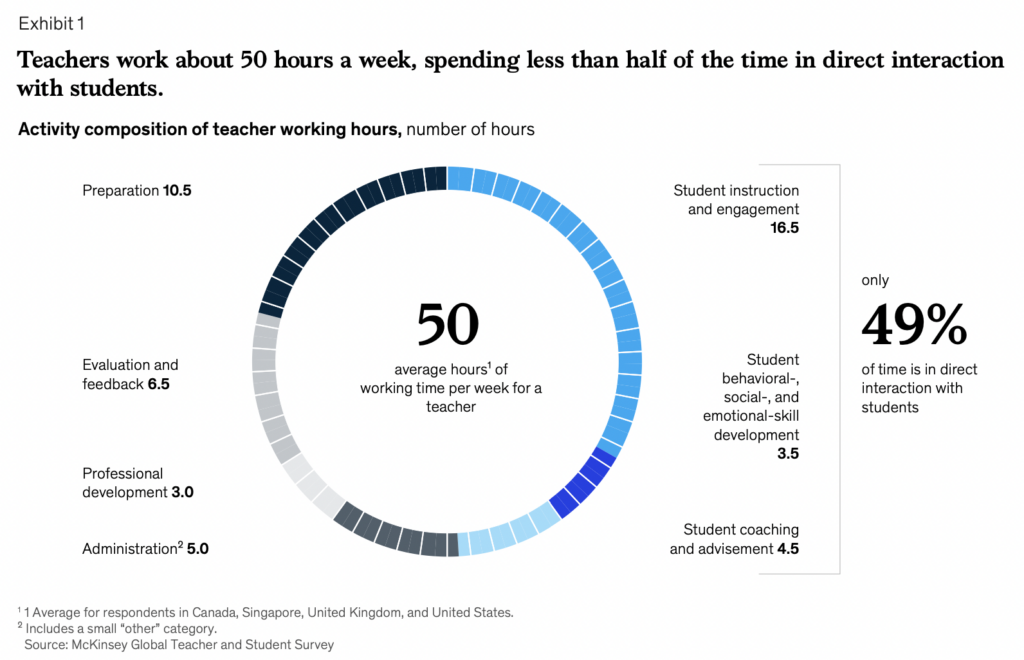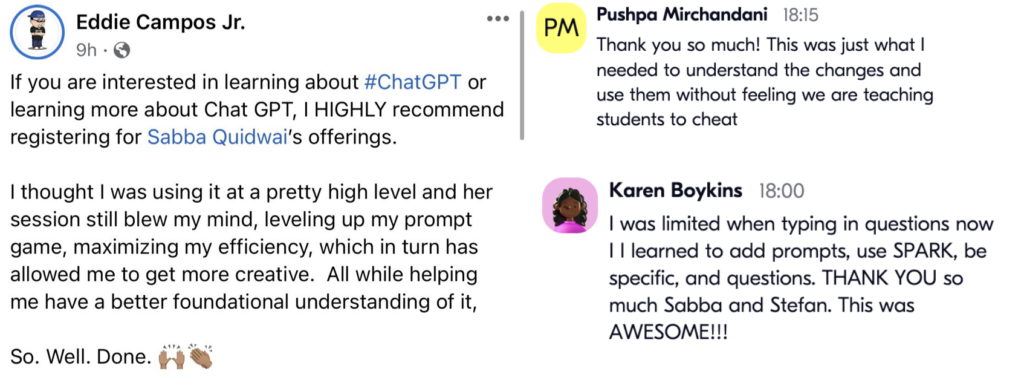Envision a world where each student has access to a robust tool that enables them to articulate their ideas, acquire new skills, and tackle complex problems. A tool that amplifies their creativity, curiosity, and collaboration. A tool making learning more enjoyable, interactive, and personalized. Sounds like a sci-fi concept, doesn’t it? Well, it’s not anymore. This tool already exists, and it’s called artificial intelligence (AI).
AI isn’t just a buzzword or a futuristic idea. It’s a reality transforming every sphere of our lives, including education. A recent McKinsey & Company report states that AI holds the potential to improve student outcomes by 30 to 40 percent and reduce the teacher workload by 20 to 50 percent.

Embracing Artificial Intelligence in K-12 Education
Contrary to common belief, AI isn’t a magical solution that will replace teachers or render them redundant. Instead, AI has the power to bolster teachers in their essential roles: inspiring students, cultivating critical thinking, and nurturing core human values. In this blog post, we’ll shed light on a compelling truth: your teaching and subject matter have never been more vital. AI isn’t here to replace the human element in education; it’s here to enhance it. So, how can we adopt AI as allies in our mission to educate future generations?

As a former social science teacher, I’ll illustrate this by using examples from English and History classes. If you’re interested in learning more about how to use AI in education then I invite you to join us in The AI Bootcamp: From Curious to Confident with AI (even if you’re short on time). You can learn more here.
Engaging with AI in High School English
You may have come across prompts like, “Act as an expert in high school English and design a lesson for the book ‘To Kill a Mockingbird’.” This likely prompted questions: What does it mean to be an expert? How do I assert my expertise? Where do I gather my information?
These are essential questions to ponder, not only for such prompts but for any interaction with AI.
In today’s digital age, where anyone can pose as an expert, and where information is abundant but not always reliable, we need to exercise critical thinking and discernment. It’s vital to know how to evaluate sources, corroborate facts, and question assumptions. That’s when our knowledge of authors, research methodologies, educational frameworks, and more becomes instrumental. This understanding aids us in formulating more effective AI prompts and using them as tools for learning and problem-solving.
Let’s consider an example. Suppose you want to design a lesson on ‘To Kill a Mockingbird’ using AI. You could use a vague prompt like the one above, or you could use a more specific one like this:
“I want you to act as an expert high school English teacher designing a lesson plan for Harper Lee’s ‘To Kill a Mockingbird’. The lesson should focus on understanding the narrative structure and perspective-taking, aligned with the California Common Core State Standard for English Language Arts & Literacy in grades 9-10 (Standard RL.9-10.5). The lesson should include a classroom activity, a real-world connection, and a blog project. Also, suggest ways AI can be integrated into the lesson.”
Which prompt do you think would yield a better result? The second one, undoubtedly. It demonstrates that you have done your research, that you understand the topic, and that you can apply your knowledge to a practical scenario.
Lesson Example:
- Classroom Learning: In the classroom, students delve into the narrative structure of “To Kill a Mockingbird” and how Harper Lee utilizes it to present varying perspectives and stimulate empathy. They could analyze how the author employs flashbacks, parallel plots, and pacing to generate tension and surprise, aligning with the mentioned standard.
- Real-World Connection: Encourage students to extend these empathy and perspective-taking lessons to their local community. They could contemplate varying viewpoints on a local issue or event, similar to how they analyzed characters in the book.
- Blog Project: Students can create blog posts presenting these diverse perspectives on a local issue, echoing the narrative techniques they studied in “To Kill a Mockingbird”. For instance, they might explore different viewpoints on a proposed community development project or a recent local event.
- AI Integration: Students can leverage AI tools to enhance their writing, and improve grammar, structure, and style. They can also use AI to analyze engagement with their posts, identify which perspectives resonate most with readers, and refine their writing accordingly.
This project links the skills developed in English class, such as understanding narrative structure and perspective-taking, with real-world community issues. It demonstrates how AI can enhance these skills and make the learning experience more engaging and relevant. It illustrates how AI is not a threat, but a tool that can enrich learning and empower students to engage with their community in meaningful ways.
Engaging with AI in High School History
In his 2018 book, “AI Superpowers,” Kai-Fu Lee posed a profound question: Which government system is best equipped to manage rapid technological advancements? His extensive exploration, informed by experiences in both the United States and China, prompts more questions than answers, sparking critical thought on a pivotal issue in our AI-driven world.
As students delve into history, they grapple with various economic and political systems, including capitalism and socialism. As we stand on the precipice of an era defined by artificial intelligence, these studies take on new urgency. A nuanced understanding of complex political, social, and economic ideologies is crucial for our learners. How can they advocate for their desired policies and priorities without a clear comprehension of these systems’ core differences?
The Industrial Revolution, a time of significant technological advancement and societal change, is a common topic in 10th-grade history and serves as a good parallel to our current era of rapid AI development.
A specific California Common Core State Standard for History/Social Science in grade 10 requires students to “Analyze the effects of industrialization and imperialism on the developing world in the late nineteenth and early twentieth century” (Standard 10.4.2).
Lesson Example
- Classroom Learning: In the classroom, students could examine the causes and effects of the Industrial Revolution, including its impact on various economic and political systems. They could discuss how technological advancements disrupted industries, transformed economies, and led to shifts in power dynamics, aligning with the mentioned standard.
- Real-World Connection: Students could then draw parallels between the Industrial Revolution and the current era of AI advancement. How are AI technologies disrupting industries today? What potential economic and political shifts might they trigger?
- Project: Task students with a research project investigating a specific AI technology and its potential impacts on different sectors of society, such as the economy, job market, or political landscape. They could use their understanding of historical events and patterns to predict potential future trends and implications.
- AI Integration: Students can use AI tools to assist with their research, such as AI-powered search engines or data analysis tools. They could also use AI to visualize their findings or create interactive presentations.
The history classroom, therefore, isn’t just a space for exploring the past but also a platform for critical thinking about our future. We ask ourselves and our students: How should AI be governed? What economic implications might it bring? Our historical discourse serves as a springboard for future-facing discussions, equipping students with the understanding needed to navigate and shape an AI-impacted society.
In the era of AI, our role as educators is more important than ever. We are not just teachers but also guides, helping our students navigate this new landscape. By integrating AI into our classrooms, we can empower our students to become lifelong learners, critical thinkers, and responsible digital citizens. Let’s embrace AI as an ally in our mission to educate the next generation.
Join The AI Bootcamp
We’re living in a future where the exponential growth of technology is transforming every aspect of our lives, including education. As educators, we are uniquely positioned to harness the power of AI to enhance our teaching and empower our students. But to do that effectively, we need to understand AI – what it is, how it works, and how we can use it as a tool for learning and problem-solving.
That’s where our AI Bootcamp comes in.
Designed for educators, our AI Bootcamp offers a hands-on, comprehensive introduction to AI in education. It’s not about learning to code or becoming a tech guru. It’s about understanding how AI can enhance what you already do best: inspire students, foster critical thinking, and nurture human values.
By joining our AI Bootcamp, you will:
- Gain a deep understanding of AI, its capabilities, and its limitations.
- Learn how to integrate AI into your teaching in meaningful and engaging ways.
- Develop the skills to critically evaluate AI tools and resources.
- Understand the ethical considerations of using AI in education.
- Join a community of forward-thinking educators who are embracing the future of learning.
As we navigate this new world of AI, it’s crucial that we, as educators, are equipped with the knowledge and skills to guide our students. Our AI Bootcamp is designed to do just that.
Ready to take the leap and make your classroom future-ready? Join us at our AI Bootcamp and take the first step towards transforming your teaching for the 21st century.
Remember, AI isn’t here to replace the human touch in education; it’s here to enhance it. Let’s embrace AI as our ally in our mission to educate the next generation.
We look forward to seeing you at the Bootcamp! Here’s a look at what others have to say.

I’m Sabba.
I believe that the future should be designed. Not left to chance.
Over the past decade, using design thinking practices I've helped schools and businesses create a culture of innovation where everyone is empowered to move from idea to impact, to address complex challenges and discover opportunities.
stay connected
designing schools